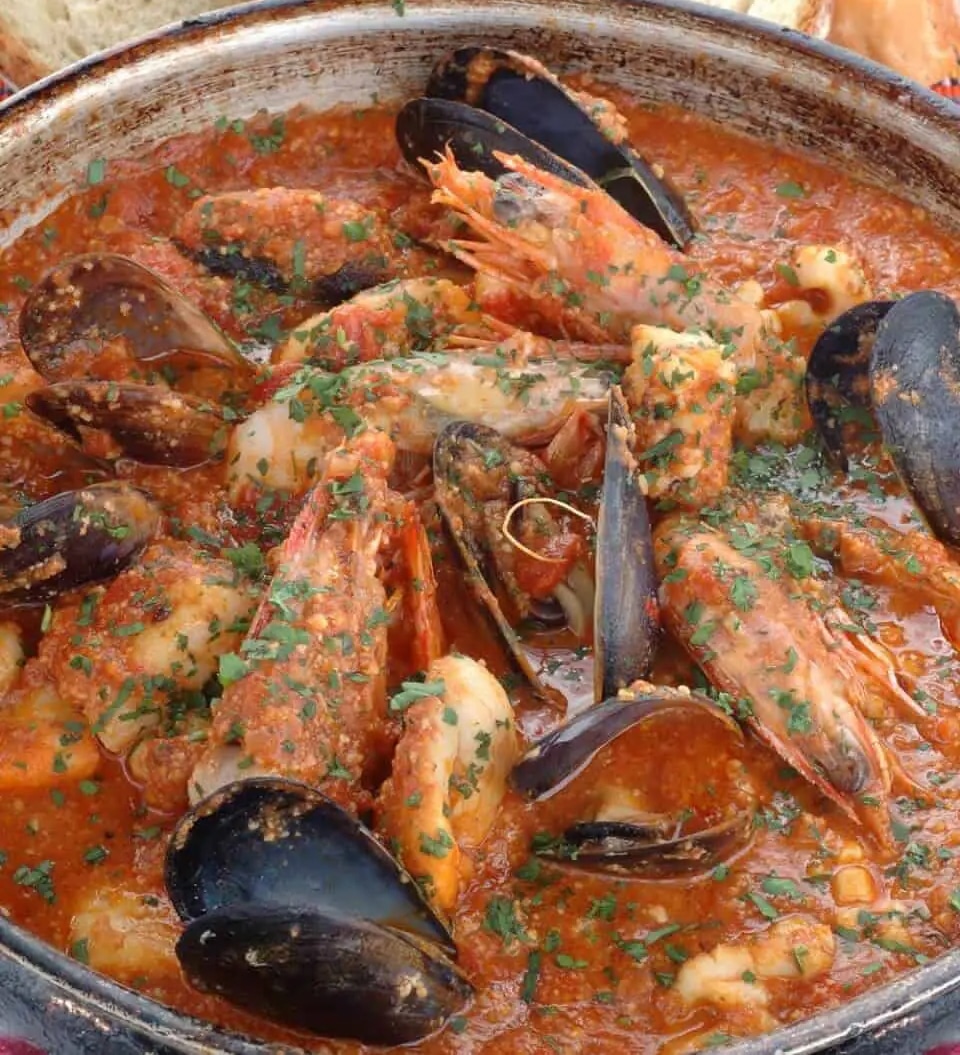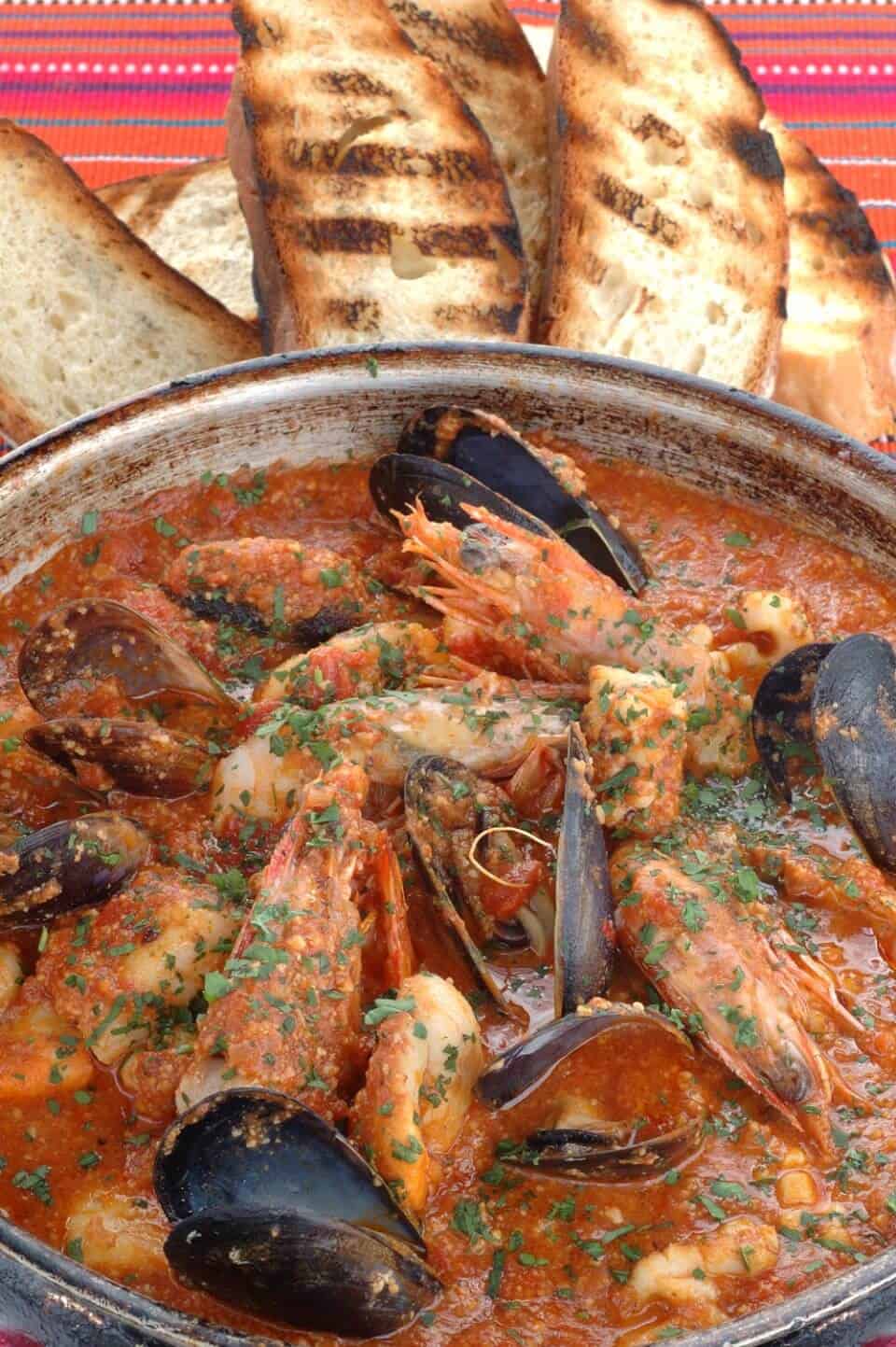Zarzuela de Mariscos (Spanish Seafood Stew)

I first ate zarzuela a few years back. A gang of us went to a Spanish restaurant for a leaving dinner for a few of the group that were off to Europe indefinitely.
It was a brilliant night with beautiful food, great friends, kitschy flamenco music, lots of sangria and many embarrassing stories from the past. The details are a little sketchy but one thing I do remember particularly well is that the restaurant was about the size of a small sailboat; it had less than 7 tables.
Despite this it was very comfortable. The seating was wooden benches scattered with randomly colored, embroidered cushions. The walls were a very warm wood covered with interesting, often brightly colored paintings in no particular theme. It all made the place incredibly social and comfortable despite its size.
I also remember the food. Now usually, with that much frivolity and sangria, I would be forgiven, even as a chef, for not remembering the food. But I remember every detail of every dish that night.
We ordered various shared tapas and were thoroughly impressed with each one. The champinones al ajillo (garlic mushrooms) were the texture of expensive meat, the mejillomes rellenos (stuffed mussels) looked and smelled as though they had crept from the net to the plate, they were that fresh. The albondigas (Spanish veal meatballs) were melt in your mouth tender, and the pollo al ajillo (garlic chicken) and tortilla Espanola were both deliciously rustic. But the dish I was most excited about was one we didn’t even order.
As we sat eating and chatting, Miguel, sitting at a table for one next to us, received his main course. Miguel was Spanish and away from home traveling. He had come to eat some food that would remind him of home. He said “This is the only place since I left Spain that do zarzuela proper.”
It was a seriously impressive looking dish sitting before him, with seafood teeming from the steaming broth as though it were a fisherman’s net. As impressive as it looked, though, it was the aroma that got my attention. It was a very different aroma to what you expect from tomato-based seafood dishes.
As quizzed Miguel about the dish, he called to the kitchen, “Juan, you have any zarzuela sauce left for these fine gentleman?” I embarrassingly mumbled, “No, no, that’s alright.” This level of comfort, shouting casually out to the chef was part of the magic of the place. Juan happily shouted back, “It’s already in the pan. I serve it in a couple a minutes!”
Obviously, the chef would not divulge his zarzuela recipe; any good restaurant’s business is built on such food. However, at the time I was working in an Italian restaurant with a very proud Spaniard, Susannah from Barcelona. She was the head waitress and always claimed Spanish things were better than all things Italian.
I asked her to get her mother’s zarzuela recipe, and she was more than happy to show our Italian boss that it was better than his traditional marinara.
I find zarzuela an absolutely magnificent dish. I hope that you enjoy discovering this little Spanish secret as much as I have.
Note: Keep in mind that this is a sort of a stew so don’t get too caught up on the actual seafood ingredients, use what you can source and what is fresh.

Zarzuela by Chef Paul Hegeman
Ingredients
- 1 onion
- 5 cloves of garlic
- 2 small red chillies
- 1 teaspoon smoked paprika
- 1/2 bunch parsley
- 2 cans whole peeled
- 2 tablespoons tomato paste
- 350 ml fish stock
- 1 small tin baby clams
- 30 black or eden mussels
- 400 grams perch fillet
- 250 grams squid tubes
- 550 grams whole green king prawns
- 400 grams scallops
- plain flour
- extra virgin olive oil
- white wine
- 50 g almonds
- 40 g hazelnuts
- sea salt flakes
- freshly ground black pepper
Instructions
- Sauté the onion, garlic, paprika, and chili pepper in oil in a medium-sized saucepan until translucent. Add a liberal splash of white wine.
- Reduce the wine until it has almost disappeared and add the tomatoes, piercing them. Rinse the tomato tins with 2 cups (500 ml) of water and add to the pot.
- Bring to the boil and reduce to a simmer for approx 1 hour.
- Add the stock and simmer for a further 1 hour. This is plenty of time to prepare the seafood.
Seafood:
- Clean and de-beard the mussels, put in the fridge. (For tips on cleaning mussels see “Cleaning Mussels” in Techniques).
- Cut the squid tubes along one edge so they are no longer a tube but lie flat .
- Gently, with a very sharp knife, score criss-cross cuts on what was the inside of the tube (approx 1 cm/about ½ an inch scores). Cut each scored squid tube into about 6 pieces, then put them in the fridge.
- I recommend you leave the heads on the prawns, but if you’d rather not, feel free to remove them at this stage.
- Remove the shell from the body of the prawns; leave the tail and head attached.
- Gently pull the prawns head forward and you will find the intestinal tract and cord running from the head to the body. Slide a skewer or the back of a small knife under this and gently pull up. By doing so the cord and tract will slide right out of the body.
- If the tract/cord breaks with some of it still in the body you will need to make a small slice along the back of the prawn and remove it from there.
- Rinse them and place in the fridge.
- Cut the perch into the same number of pieces as you have guests, rinse and refrigerate.
- Rinse the scallops and place in the fridge.
The rest:
- Toast the almonds and hazelnuts in a dry pan over medium heat until golden brown. Immediately remove from the pan and allow to cool slightly.
- Place the parsley (leave a little aside for garnish) in a food processor with the nuts and process on high, add 2 tbsps olive oil and process on high until smooth.
- Stir this into the tomato sauce together with the fish stock, bring it all to the boil and reduce to simmer.
- Add some salt and pepper to some flour and lightly coat the squid pieces. Fry them on high in a large deep pan in a liberal amount of oil for a couple of minutes.
- Repeat the same process for the perch.
- Clean the pan, return to the heat with some more oil, and fry the prawns on high for a minute or two.
- Add the mussels, squid, clams, and a little of the clam brine and pour in the simmering sauce. Reduce the heat to medium and add the scallops and perch.
- Once the mussels have all opened, all the other seafood should be perfectly cooked. Season to taste.
- Depending on the occasion, you may want to just place the pan on the table with a chopping board of bread, or you may want to plate it up. If so, arrange your 4 plates and divide the seafood evenly among them using a set of tongs, and then ladle the sauce over. Sprinkle over some parsley and serve with a red or white wine.
Notes

Related: Top 25 Favorite Spanish Foods
Related: Bouillabaisse
Related: 15 Popular Catalan Foods

